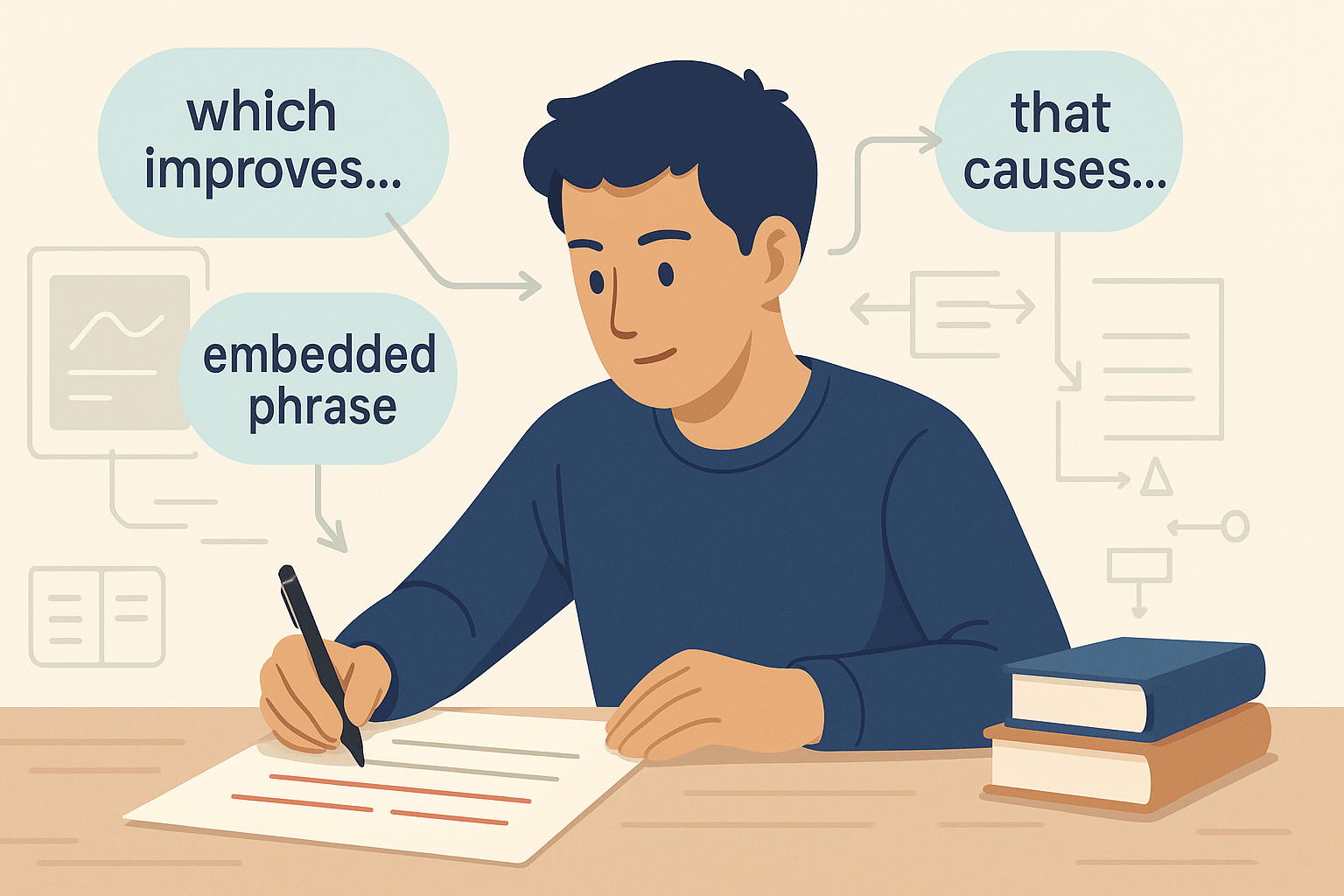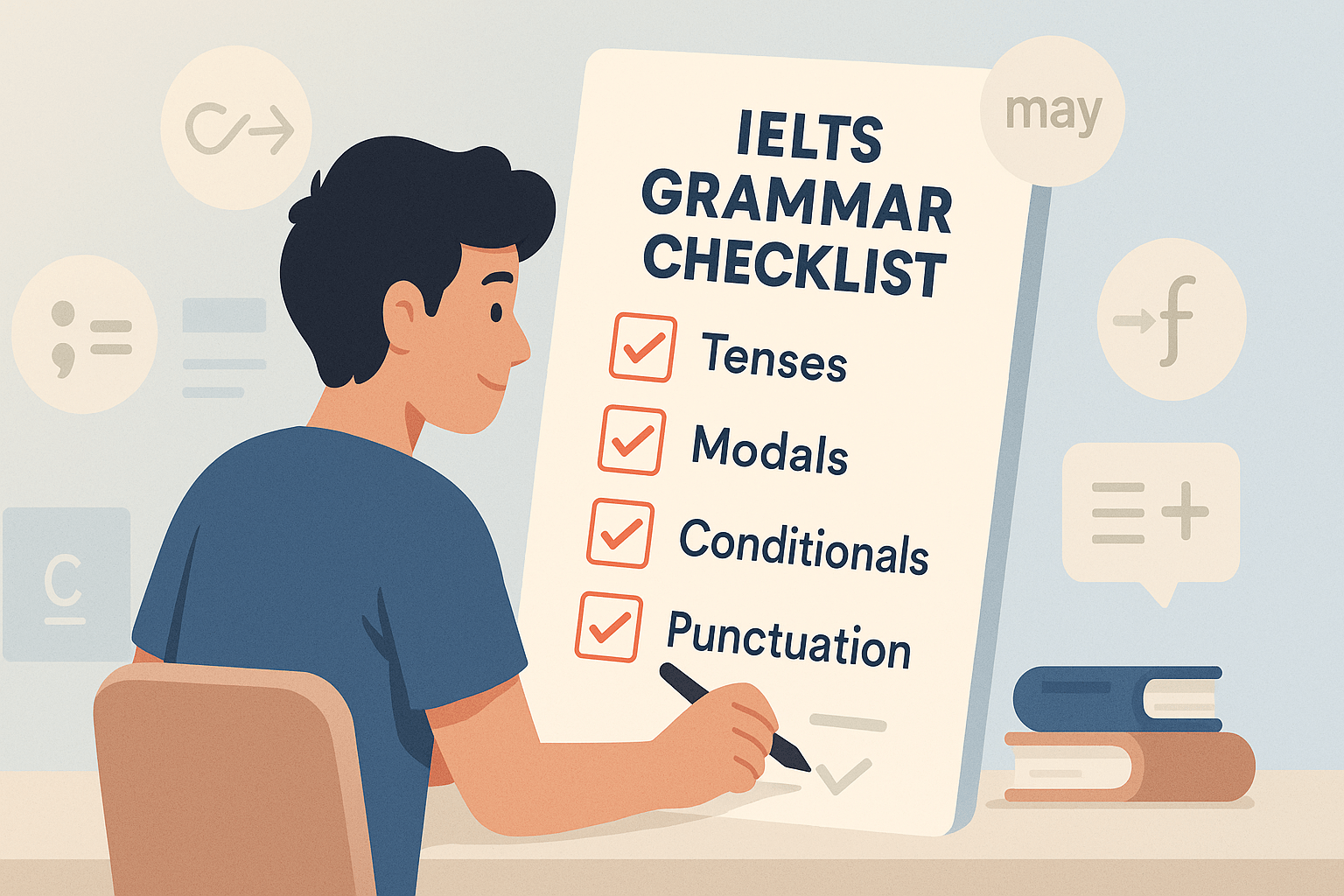One of the most effective ways to upgrade your IELTS Writing Task 2 essays from Band 6 to Band 7–9 is to use complex grammar naturally.
When my students ask, “How do I make my sentences sound academic and cohesive?”, I always introduce them to relative clauses and embedded phrases.
“If your essay is full of simple, disconnected sentences, it will never reach Band 7+. But if you connect ideas using relative clauses and embed phrases smoothly, your writing will flow like a professional academic essay.”
In this guide, I’ll teach you:
- ✅ What relative clauses are and how to use them in IELTS Writing
- ✅ How embedded phrases make your sentences more academic
- ✅ Examples of Band 9 sentences using these structures
- ✅ Common mistakes to avoid
For a complete overview of high-band grammar, check my IELTS Writing Task 2 Grammar for Band 7–9.
Why Use IELTS Relative Clauses in Writing Task 2?
Relative clauses help you combine ideas into one cohesive sentence, making your essay:
- ✅ More academic and formal
- ✅ Easier to read for the examiner
- ✅ Stronger in Grammatical Range and Accuracy (25% of your score)
AEO Snippet Answer:
IELTS relative clauses allow writers to connect ideas, explain details, and create complex academic sentences that improve coherence and band scores.
Check official band descriptors for more grammar insights:
Understanding Relative Clauses
A relative clause adds extra information about a noun using words like:
- who → for people
- which → for things
- that → for people or things
- whose → for possession
- where / when → for place or time
Example:
“Governments should support public transport, which can reduce traffic congestion and pollution.”
- ✅ Adds extra detail without starting a new sentence
- ✅ Shows complex grammar usage naturally
Two Types of Relative Clauses
- Defining Relative Clauses (Essential Information)
- Identify or define the noun
- “The policies that reduce carbon emissions are the most effective.”
- Non-Defining Relative Clauses (Extra Information)
- Add extra info (use commas)
- “Electric cars, which produce no emissions, are becoming popular in urban areas.”
Using Embedded Phrases for Academic Style
Embedded phrases are short descriptive groups of words within a sentence that make writing concise and formal.
Example:
“Many countries, facing rapid urbanization, are investing in public transport.”
Here, “facing rapid urbanization” is an embedded phrase providing extra info without starting a new sentence.
Other forms of embedded phrases include:
- Present participle phrases: “The city, struggling with air pollution, introduced new policies.”
- Past participle phrases: “Several measures, implemented last year, have reduced unemployment.”
- Prepositional phrases: “Students, in most developing countries, often face resource shortages.”
Why it matters:
- ✅ Keeps your sentences compact and academic
- ✅ Reduces repetitive sentence openings
- ✅ Helps Band 8–9 candidates show grammar flexibility
Sample Band 9 Paragraph Using Relative Clauses and Embedded Phrases
“Urban areas, which are experiencing rapid population growth, face increasing pressure on housing and transportation. Governments, attempting to address these challenges, have introduced public transport expansions and stricter vehicle regulations. These measures, which were implemented across several cities last year, have already shown positive results in reducing traffic congestion and air pollution.”
Why this works:
- ✅ Mixes relative clauses and embedded phrases naturally
- ✅ Improves flow and coherence
- ✅ Demonstrates advanced grammatical range
Common Mistakes to Avoid
Even strong candidates sometimes lose marks by misusing these structures.
- Overloading sentences
- ❌ “The city, which is very crowded, which has many cars, which is noisy, has pollution problems.”
- ✅ Combine or reduce clauses: “The city, which is crowded and full of cars, suffers from pollution problems.”
- Misplacing embedded phrases
- ❌ “The government introduced policies facing traffic problems.” (Confusing)
- ✅ “The government, facing traffic problems, introduced new policies.”
- Using informal “which” incorrectly
- ❌ “People like social media, which is bad.” (Too casual)
- ✅ “Many people use social media, which may negatively affect face-to-face interactions.”
Quick Practice Exercise
Rewrite the sentences using IELTS relative clauses or embedded phrases:
- “The country has rising pollution. The country depends on coal energy.”
- ✅ “The country, which depends on coal energy, has rising pollution.”
- “Students are stressed. They are preparing for final exams.”
- ✅ “Students, preparing for final exams, are often stressed.”
FAQ Section
Q1: How do IELTS relative clauses improve my Task 2 score?
They create complex, cohesive sentences, which boosts Grammatical Range and Accuracy, essential for Band 7–9.
Q2: What are embedded phrases, and why are they useful?
Embedded phrases are descriptive elements placed within a sentence. They make writing concise and academic.
Q3: Can I overuse relative clauses in my IELTS essay?
Yes. Overloading sentences makes writing hard to read. Use 1–2 per paragraph for natural flow.
Conclusion
Mastering IELTS relative clauses and embedded phrases is a game-changer for Writing Task 2.
When you:
- ✅ Combine ideas into cohesive, complex sentences
- ✅ Use embedded phrases for academic conciseness
- ✅ Avoid overloading or misplacing clauses
… your essay will impress examiners and push your writing into Band 7–9 territory.
🔗 Next step: Combine relative clauses with modals, conditionals, and cohesive sentence structures from our IELTS Writing Task 2 Grammar for Band 7–9 to craft truly high-scoring essays.





One Response
I just wanted to drop by and say how much I appreciate your blog. Your writing style is both engaging and informative, making it a pleasure to read. Looking forward to your future posts!